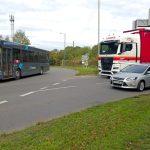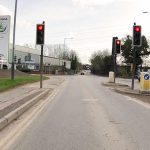An appropriate response to a consultation submission?
Just a quick thing...
I have chosen not to use adverts, pop-ups, mailing lists, or mandatory subscriptions, but it means there is an ongoing cost for me in researching and writing content, and generally advocating for active travel - time spent not working! If you can throw a few pounds my way to help out, your support is gratefully received! Thank you!

Update 18 July 2024
According to official minutes, the decision on the Croft Road scheme has been deferred until further notice. At this time, no detail is given as to why and I wouldn’t want to speculate that it might be due to the issues I raised with the Portfolio Holder’s Report. Of course, it does not mean that there will be any changes to the scheme, nor that the scheme will not ultimately be approved; just that the decision will be made at a later date.
No reply was received from officers after I wrote to express my concerns, however with time pressing I did contact the Portfolio Holder directly who noted he would consider my email and all comments in his decision-making.
Original article
Recently, Warwickshire County Council ran a short consultation on installing speed cushions on Croft Road, Nuneaton. Responding to that, an objection submitted by yours truly noted the issues these can cause for cycling, including the potential increase in the risk from close passes, and in particular the impact on accessible cycling – points that appear to have been ignored in the Portfolio Holder’s Report.
Whilst I am aware that a consultation is not a vote or a referendum on Council plans, nor does the local authority have to agree with the points I’ve raised, a short and disregarding officer response in that Report is surely not sufficient to allow the Portfolio Holder to properly evaluate the scheme and the consultation feedback, and therefore would be likely to end in poor – or at least uninformed – decision-making.
Perhaps I’m barking up the wrong tree here, dear reader, so I’ll leave it to you to decide. Below you can see my objections to the scheme, and the relevant extracts from the Report showing the officer responses. A link to the full report, which includes full scheme details, is also included. Whether or not you agree with the objections I have raised, is the response from the Council sufficient to suggest they’ve been considered and addressed?
I have, of course, written back and asked about this as a point of curiosity. If a reply is received, an addendum will be added to this post.
The scheme
The scheme involves the installation of 8 sets of Road Humps (Speed Cushions) along Croft Road (with between 2 or 3 no. Cushions per set) to reduce vehicle speeds along this section of road. The scheme will help improve the environment for residents, pedestrians and cyclists, by restricting vehicle speeds and improving road safety.
Extract from Warwickshire’s Statement of Reasons
The Objection
The following is the objection I submitted in response, which can be seen in the Portfolio Holder’s Report, along with nineteen other representations.
I would like to make the following comments in objection to the County Council’s proposal to install a series of speed cushions along Croft Road, Nuneaton.
Please be aware that this objection does not cover the general concept of traffic calming and improving the safety of the environment for all road users including pedestrians and cyclists, which is clearly important. This objection is specific to the speed cushion plan as it currently stands.
Speed cushions, as per the plans, do not cover the full width of the carriageway. As a result, they present as less of a hinderance for drivers of larger vehicles which can straddle the cushions. In the course of positioning a vehicle in such a manner to achieve this, a driver may put their vehicle into conflict with other road users, for example by moving nearside which may result in a dangerous close pass of a cyclist, or worse an actual collision.
Again noting that the cushion does not cover the full width of the road, this results in limited space for a cyclist to bypass the cushion, encouraging riders to either a) move too far to the nearside, encouraging close passes; b) attempt to bypass centrally in the carriageway which may present its own risks and challenges to the rider, particularly less confident cyclists; c) attempt to ride over the cushion which may be challenging to less confident riders and uncomfortable for those with certain disabilities, particularly if they feel the need to ride at speed to keep up with motor traffic.
Riders of tricycles and other similar cycles may be put at risk by the height difference between the trough and peak of the cushioned area, where the cycle may not fit entirely within the space between cushions, or the kerb and cushion. Cycling between cushions may be dangerous or challenging for some riders.
On this point, I refer you to a comment made by Wheels for Wellbeing:
“Speed cushions – these can create unavoidable cambers which might cause three-wheelers (e.g. tricycles) to tip over. Cycling between speed cushions is the most stable solution, but this can force cyclists into dangerous cycling positions and out into the middle of the road.”
This therefore may present as an accessibility issue under the Equality Act 2010 where disabled riders of non-standard cycles are unfairly disadvantaged.
There is no plan communicated alongside this proposal to make other, more meaningful measures (see below) to reduce speeds or vehicle use and improve safety on a residential main road that serves bus stops, is on a route to a nearby school, and has other local amenities nearby which may require the use or crossing of Croft Road.
As it stands, this scheme appears to be barely more than a token effort to reduce driver speeds while not making fundamental differences to the local environment that will meaningfully improve the area for walking, wheeling, and cycling. The area is extremely poorly served by genuine active travel connections where even the advisory on-road links as communicated on the Council’s cycling map for Nuneaton offer no actual infrastructure, are dangerous particularly at peak traffic times, and in no way enable people to choose active travel for their local journeys.
As demonstrated, speed cushions can worsen dangers for cycling and this is therefore contrary to a clear stated objective of the scheme.
The Warwickshire Road Safety Partnership has adopted a Safe Systems Approach to road safety, whereby conflict and risk should be designed out as far as possible. Yet this proposal designs in the possibility of conflict and risk through increasing the chance of close passes at speed cushions, the hazards for three-wheeled cycles, and the risks incurred by some cyclists (including less confident and inexperienced riders of all ages) moving to avoid speed cushions.
As per the county’s Local Transport Plan (LTP4) which was recently approved by county councillors, active travel modes are at the top of the transport choice hierarchy. This proposal does not align with LTP4 in a number of areas, including:
- It does not meet three of the four key themes (Environment, Wellbeing, Place);
- As an urban space, the route should be seen as important for increasing active travel, yet it does not contribute to enabling that choice and can worsen it;
- It does not seek to reduce motor vehicle usage;
- It does not meet a Safe Systems Approach (as also noted above);
- It fails to meet key priorities AT1 and AT2 for active travel.
- It does not significantly contribute to the Council’s net zero goals;
This scheme should therefore be revisited as follows:
Objection sent in response to the consultation, 29 March 2024
- Implement a formal 20mph speed limit.
- Reduce carriageway width and reallocate space to provide a safer route for cycling.
- Provide full-width speed bumps that drivers cannot avoid, while noting that if cyclists are expected to be in the main carriageway, these should be no more severe than is necessary to ensure comfortable transit for those riding any form of cycle.
Relevant officer responses
These responses are taken from the Portfolio Holder’s Report. Aside from the problems detailed with these responses, overall there is no consideration to the alignment with polices (e.g., the Local Transport Plan, or the Safer Systems Approach), and no acknowledgement of potential accessibility issues nor obligations under the Equality Act.
Objection 2
Objection: “Suggestions that alternative measures such as Average Speed Cameras or signalised crossing points should be installed at this location instead with objectors feeling those would represent a better use of resources.”
Response: “In order for a speed camera to be installed at a location it must meet criteria set out by the Department of Transport (DFT Circular 01/2007). Warwickshire County Council are not currently considering any new Average Speed Camera sites until the current Pilot Scheme has been completed in order to fully assess the effectiveness of them. Speed cameras are mainly located on main carriageways and trunk roads and not in residential areas such as Croft Road. Similarly, signals and a signalised crossing would not meet the required criteria for this location.”
The response to this objection is entirely focused on just three examples (speed cameras, signals, and a signalised crossing). Other suggestions have been made including a reduced speed limit and cycle infrastructure. Other options might be available including alternative traffic calming methods. The response does not justify the choice of calming method.
Objection 6
Objection: “Concerns expressed that the measures don’t span the whole width of the road, resulting in cars going through the middle of them.”
Response: “There are a total of 8 planned sets of cushions, totalling 20 individual cushions. The sets differ as some areas of the carriageway are wider than others. In the wide sections there will x3 cushions installed in order to prevent vehicles from travelling through the middle of the cushions avoiding the speed reduction measures. A full schedule of the cushions proposed can be found in Appendices 3, 4 & 5. The Scheme has also been designed to ensure that there will be sufficient space for a cyclist to pass along the cushion. The installation of these measures will not discourage active travel.”
Here, there appears to be a misunderstanding of driver behaviour. The concern (at least from my point of view) is not that drivers will attempt to drive between cushions, rather that with the increasing size of modern cars they will attempt to position the vehicle to straddle a cushion. The response suggests the scheme will not discourage active travel, but the risk of drivers moving nearside to straddle a speed cushion increases the risk of a close pass, increasing the perception, if not the actual risk of danger.
It is also noted that the scheme has apparantly been designed to ensure sufficient space for cyclists to pass, but no reference is made to this space being of accessible width i.e., 1.5m, nor the risks involved should a three-wheeled attempt to pass with insufficient space. More on space for cycling is covered in Objection 7, below.
Objection 7
Objection: “Concerns for cyclists as the scheme does not provide a sufficient width for a cyclist to pass by.”
Response: “There are a total of 8 planned sets of cushions, totalling 20 individual cushions. The sets differ as some areas of the carriageway are wider than others. In the wide sections there will x3 cushions installed in order to prevent vehicles from travelling through the middle of the cushions avoiding the speed reduction measures. A full schedule of the cushions proposed can be found in Appendices 3, 4 & 5. The Scheme has also been designed to ensure that there will be sufficient space for a cyclist to pass along the cushion. The installation of these measures will not discourage active travel.”
Yes, this is a copy-paste response to Objection 6, rather than it being considered and responded to independently. Again, no reference has been made to accessible cycling and the issues that, for example, a three-wheeled cycle rider might face should they attempt to pass through the restriction with insufficient space.
In fact, based on a diagram and cushion specifications given in the report (Pages 13 and 21-22 respectively), and a road width measurement from Google Maps, a space of approximately 1.25m would appear to be given around and between at least one set of cushions. Factoring in a rider’s position from the kerb edge, that the minimum space for accessible cycling should be 1.5m, and the mentioned risks from close passes where drivers may move nearside to straddle the speed cushion, the space would in fact appear to be inadequate.







One of my few achievements in local politics was getting planning officers to include a summary of objections in planning application reports. Before that, it was assumed that interested councillors would read the planning file.
So, my response would be that if you felt the report mis-characterised your submission, to write and complain. If you think the report is unreasonable, complain that they are acting unreasonably – complaints of unreasonable behaviour is kryptonite to a council officer.
I’ve sent an email asking why a lot of points appear to have been missed. Hopefully I’ll get a reply early next week before the meeting.